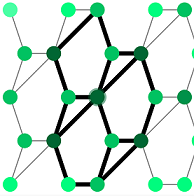The neighbourhood of node $v$ in graph $G$ is the subgraph of $G$ induced by all vertices adjacent to $v$.
The number of edges between neighbours divided by the number of pairs of neighbours is the so-called clustering coefficient $c$. The first node has $c = 6 / \binom{6}{2} = 0.4$, the second $c = 2 / \binom{5}{2} = 0.2$, the third $c = 0$
You now may add nodes at larger distances from node $v$ to its neighbourhood when they lie on minimal cycles going through $v$:
My first question is: What's the official name of such "closed neighbourhoods"? For tilings the closed neighbourhood of a vertex is essentially its vertex configuration, but what about the general case? Would one call the closed neighbourhood "vertex configuration", too?
In any case, the concept of clustering coefficients now can be generalized. Let me first note that the name "clustering coefficient" is not the best that could have been chosen. It is true that triangles are complete graphs $K_3$ and thus are clusters, but they are also cycles, i.e. cycle graphs $C_3$, and so "cycle coefficient" would have been an equivalent name – or to be specific: "3-cycle coefficient".
The concept of clustering coefficients – considered as cycle coefficients – can be generalized quite naturally: The $k$-cycle coefficient $c_k$ of a node $v$ is the number of induced minimal $k$-cycles $C_k$ it lies on, divided by the number of possible such $k$-cycles. The overall cycle coefficient $\mathbf{c}$ can then be defined as the sum $\mathbf{c} = \sum_{k=3}^n c_k$ and cannot exceed 1 which is achieved exactly for the nodes of the complete graph $K_n$, for which $c_k = \delta_{k3}$. For the cycle graph $C_n$ the cycle coefficient of all nodes is $\mathbf{c} = 1 / n!$. For trees we have of course $\mathbf{c} = 0$.
Reference request: Under which name (and where) are such "cycle coefficients" investigated in the literature?





